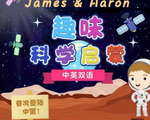新概念英语第三册课文Lesson 38 The first calendar 最早的日历
 James&Aaron 趣味科学启蒙(中英双语)
James&Aaron 趣味科学启蒙(中英双语)
》》》点击查看:新概念英语第三册课文
新概念英语第三册课文Lesson 38 The first calendar 最早的日历
Future historians will be in a unique position when they come torecord the history of our own times. They will hardly know whichfacts to select from the great mass of evidence that steadilyaccumulates. What is more, they will not have to rely solely on thewritten word. Films, videos, CDs and CD-ROMs are just some ofthe bewildering amount of information they will have. They willbe able, as it were, to see and hear us in action. But the historian attempting to reconstruct the distant past isalways faced with a difficult task. He has to deduce what he can from the few scanty clues available. Even seemingly insignificant remains can shed interesting light on the history of early man.
Up to now, historians have assumed that calendars came into being with the advent of agriculture, for then man was faced with a real need to understand something about the seasons. Recent scientific evidence seems to indicate that this assumption is incorrect.
Historians have long been puzzled by dots, lines and symbols which have been engraved on walls, bones, and the ivory tusks of mammoths. The nomads who made these markings lived by hunting andfishing during the last Ice Age which began about 35, 000 B. C. and ended about 10, 000 B. C. By correlating markings made in various parts of the world, historians have been able to read this difficult code. They have found that it is connected with the passage of days and the phases of the moon. It is, in fact, a primitive typeof calendar. It has long been known that the hunting scenes depicted on walls were not simply a form of artistic expression. They had a definite meaning, for they were as near as early man could get to writing. It is possible that there is a definite relation between these paintings and the markings that sometimes accompany them. It seems that man was making a real effort to understand the seasons 20, 000 years earlier than has been supposed.
New Words and Expressions 生词和短语
calendar (title) /'kælində/ n. 历法,日历
historian (1. 1) /hi'stɔ:riən/ n. 历史学家
unique (1. 1) /ju'ni:k/ adj. 无与伦比的
steadily (1. 3) /'stedili/ adv. 不断地
solely (1. 4) /'səuli/ adv. 唯一地
video (1. 5) /'vidiəu/ n. 录像
CD-ROM (1. 5) /'si:-di:-'rɔm/ n. (只读)光盘驱动器
bewilder (1. 6) /bi'wildə/ v. 令人眼花缭乱
deduce (1. 8) /di'dju:s/ v. 推断,推理
scanty (1. 8) /'skænti/ adj. 不足的,贫乏的
clue (1. 8) /klu:/ n. 线索
insignificant (1. 9) /insig'nifikənt/ adj. 不重要的
shed (1. 9 ) /ʃed/ v. 使流出,泻
advent (1. 10). /'ædvent/ n. 出现,到来,来临
agriculture (1. 10) /'ægri'kʌltʃə/ n. 农业
assumption (1. 12) /ə'sʌmpʃən/ n. 假定,设想
dot (1. 13) /dɔt/ n. 小圆点
symbol (1. 13) /'simbəl/ n. 符号
engrave (1. 13) /in'greiv/ v. 雕刻
ivory (1. 14) /'aivəri/ n. 象牙制品
mammoth (1. 14)/ 'mæməθ/n. (古)长毛象
phase (1. 17) /feis/ n. 月相,天相
tusk (1. 14) /tʌsk/n. 獠牙,长牙、象牙
primitive (1. 17) /'primitiv/adj. 原始的
nomad (1. 14) /'nəumæd/n. 游牧民
depict (1. 18) / di'pikt/v. 描画,描绘
correlate (1. 15) /'kɔrileit/v. 使相互联系
Notes on the text 课文注释
1 what is more,作“而且”、“再者”解,是插入语。
2 CD-ROM,是 compact disc read-only memory的缩写。
3 as it were,“可以说”,是插入语。
4 be faced with,作“面临”、“面对”解。
5 shed light on…,使清楚地显出来,解释。
6 come into being,产生,形成。
7 Ice Age,冰川时期。
参考译文
未来的历史学家在写我们这一段历史的时候会别具一格。对于逐渐积累起来的庞大材料,他们几乎不知道选取哪些好,而且,也不必完全依赖文字材料。电影、录像、光盘和光盘驱动器只是能为他们提供令人眼花缭乱的大量信息的几种手段。他们能够身临其境般地观看我们做事,倾听我们讲话。但是,历史学家企图重现遥远的过去可是一项艰巨的任务,他们必须根据现有的不充分的线索进行推理。即使看起来微不足道的遗物,也可能揭示人类早期历史中的一些有趣的内容。
历史学家迄今认为日历是随农业的问世而出现的,因为当时人们面临着了解四季的实际需要。但近期科学研究发现,好像这种假设是不正确的。
长期以来,历史学家一直对雕刻在墙壁上、骨头上、古代长毛象的象牙上的点、线和形形色色的符号感到困惑不解。这些痕迹是游牧人留下的,他们生活在从公元前约 35,000年到公元前10,000年的冰川期的末期,以狩猎、捕鱼为生。历史学家通过把世界各地留下的这种痕迹放在一起研究,终于弄懂了这种费解的代码。他们发现代码与昼夜更迭和月亮圆缺有关,事实上是一种最原始的日历。大家早就知道,画在墙上的狩猎图景并不是单纯的艺术表现形式,它们有着一定的含义,因为它们已接近古代人的文字形式。有时,这种图画与墙壁上的刻痕共存,它们之间可能有一定的联系。看来人类早就致力于探索四季变迁了,比人们想像的要早20,000年。





